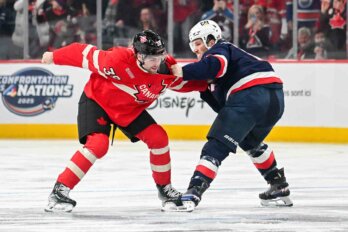DeMar DeRozan, the Toronto Raptors’ best player, doesn’t say much, except to say, as he did to a reporter in January, “Me, I never say much.” In a personality-driven league such as the National Basketball Association, DeRozan is an anomaly. Stars such as LeBron James, Russell Westbrook, and Steph Curry become polished performers in front of a microphone. DeRozan retreats. His confidence falls away, at times leaving him stumbling over his words. It can seem he’d rather be anywhere else.
DeRozan is living an unusual career arc. If the NBA hierarchy is a stairwell, basketball’s true stars typically get to the top in leaps and bounds. Their superiority is tied to the blatancy of their breakthrough. DeRozan, instead, climbed the steps one at a time, improving so slowly that it’s become nearly impossible to see how he’s arrived at his current supremacy. DeRozan modelled his game after his childhood hero, Kobe Bryant, and the NBA world he roamed. Bryant’s career was built around isolation scoring, which is the simplest and most glorified offence in basketball. Four players scatter, taking their defenders with them, leaving the fifth alone with his defender and the ball. One-on-one. A star player would then take a remarkable percentage of his team’s shots, dictating through volume the flow of a game.
DeRozan, like Bryant, was dominant in isolation; if he got a defender to himself, he’d disorient him with balletic footwork or rise up to nail a jump shot. He was selected to his first all-star game in 2014 and took the Raptors to the conference finals two years later. That summer, he was named to the Team USA Olympic basketball team, solidifying his place amongst basketball’s ruling class. But while the incremental process of his ascension rendered his achievement largely unseen and unappreciated, his rise coincided with a sudden and comprehensive shift, driven largely by data analytics, in the way professional basketball is played. The game is faster, more open, and more team-oriented than ever before. All five players on offence are involved now and rapid ball movement creates space that an old-fashioned clear-out—which allowed a ball handler to take on his defender one-on-one—never could. A by-product has been to make volume scorers outmoded. Players like DeRozan, while talented, were told they don’t contribute to championship basketball.
The Raptors franchise had been waiting since inception for a star who’d stay. Tracy McGrady left, Vince Carter left, Chris Bosh left. DeRozan, the wiry kid from Compton, California, was here without an exit strategy. But the NBA he grew up with had changed. So, even as he continued to accomplish things no Raptor in history had accomplished, there was a vocal subsection of fans and media who felt the team would be better off without him. We now know they were wrong; it’s time to figure out why.
Sports such as hockey and football progress cyclically, vacillating between styles of play as the market corrects itself (over the last twenty years, the NHL has gone back and forth between believing in speed and skill and believing in size and grit). Basketball evolves in radical leaps, always in search of the next paradigm shift. The current movement, spurred by Steve Nash’s Phoenix Suns last decade and accelerated by the Golden State Warriors, is built on the principles of pace and space: to increase efficiency, the ball should move faster and find more of the court. To accomplish this, teams push their offence in transition at a speed that once seemed impossible and, once they cross half court, attempt an extraordinary number of three-pointers—at least ten more per game than just six years ago. The modern NBA offence, then, is built around players who can do one of two things: get to the basket like LeBron James or shoot from deep like Steph Curry. Or, preferably, both.
This has been unquestionably good for basketball. The era it succeeded was slower, more plodding, and more predictable. As the game changed, basketball fandom moved in stride. Seemingly overnight, players in the mould of past heroes—Allen Iverson, Bryant—who made their living putting up huge numbers of two-point jumpshots, were labelled regressive. No matter their talent, a star player without a reliable three-pointer constricted his team’s offence. This wasn’t prejudice, but measurable fact.
In this new era, DeRozan became polarizing. Watching him travel through crowded space, lithe and rhythmic, was hypnotic. His jumpshot was pure and his footwork nearly unmatched. But his skill set didn’t seem to fit the modern game. Once his feet fell behind the three-point line, his once-beautiful shot would often become spastic and broken. He moved his offence slowly and deliberately and, when pressured, seemed incapable of finding the right pass. Most damningly, come playoff time, DeRozan’s one-dimensional game was consistently exposed by attacking defences. Why was an athlete bent on self-improvement so incapable, or unwilling, to evolve? How was a man so obsessive in film study unable to see what any fan with a Twitter account already knew? Basketball had changed, and DeRozan, it seemed, refused to join it.
Despite these shortcomings, there was plenty of good. DeRozan was a marvellous scorer, leading a statistically elite offence. Each year, the Raptors landed among the most-efficient scoring teams in basketball. Still, the league would not take him seriously. Following the 2016 season, in which he was a top-ten scorer, Sports Illustrated ranked DeRozan the forty-sixth best player in the NBA . The next season, when he was a top-five scorer, they ranked him just thirty-sixth. DeRozan did not just have limited range or poor shot selection. He was against the sweeping tide of progress.
There was something else at work that made DeRozan a target. The tone of dismissal was not just analytical but personal. Last month, Nathaniel Friedman argued in GQ that, in the twenty years since Iverson became the most polarizing athlete in basketball, NBA fandom has become “team-agnostic.” Part of basketball’s appeal has always been the game’s intimacy. Since Iverson, players have more fully captured the fan’s attention outside of team success. This is good for the league—it creates compelling narratives and insulates the product’s value even when a team is losing.
What this attention has also done, though, is create a culture of fandom that demands outspokenness, brashness, or comedic relief from its object. It emphasizes personality over character. DeRozan prefers privacy. We learned recently that, for much of this season, he’s been flying across the continent to be with his sick father in California—a secret that wasn’t supposed to get out. DeRozan hopes his actions define him. He famously spends New Year’s Eve watching game film. The gym in Compton’s Leuders Park is named after him, thanks to his dedication to community. He’s fiercely loyal to Toronto and beloved by players league-wide. In today’s version of NBA fandom, though, those traits often come second to a good sound bite.
More broadly, DeRozan fell victim to the corroding effect of immediate expectations. Basketball’s rapid evolution has, mostly by chance, tracked closely with our collective social-media obsession. It fits, then, that many of the lessons of online life apply to DeRozan. Clive Thompson recently wrote in This that one of social media’s more dangerous aspects is its ability to wash through time and historical context. “Present-mindedness,” he writes, “is our biggest danger.” In the NBA , this is no different. Success and failure are measured instantaneously. Athletes are dubbed future stars and then washed up all before the age of twenty-five. Just look at Canadian former-phenom Andrew Wiggins. When he was drafted first overall in 2014, he was a future Hall-of-Famer. Now, amidst a young career where success has come in fits and starts, many are wondering if the twenty-two-year-old will ever meet expectations.
But the burden of immediate success is not just unfair to those under judgment it’s also contrary to how people develop and grow. It’s true that peak physical performance declines in an athlete’s mid-twenties. His career window is sadistically narrow. Often, though, an athlete’s most successful years do not align with his physical peak. Instead, as he matures, develops his skill set, and masters the psychological side of sport, the athlete finds more success beyond what he had when he could run fastest or jump highest. Take the year of the Indiana Pacer’s Victor Oladipo. Once a tantalizing prospect, Oladipo had been all but written off going into this season, having turned twenty-five last May and already on his third team. Oladipo has shattered expectations, suddenly playing like a star. Surprise is warranted given his struggles, but maybe we should stop being shocked when someone’s development isn’t perfectly linear. DeRozan was a talented twentysomething who came from nothing, was one of the best in the world, and had an incredible work ethic. Still, the conversation focused on all the things he would never accomplish.
The 2016 playoffs, then, were to be a referendum on DeRozan. It was the final year of his contract, and the team was talented enough to finally make a deep run. In the opening series against Indiana, though, DeRozan struggled with his shot and often seemed lost. He couldn’t find the game’s rhythm, alternately pushing too hard and withholding too much. His play was stilted, awkward, and entirely joyless. Instead, it was Raptors’ rookie guard Norman Powell who played inspired basketball, energizing the team and fan base with gritty defence, powerful dunks, and timely three-pointers. So, as the Raptors limped onward, the narrative surrounding DeRozan’s upcoming contract negotiations built to crescendo: the Raptors should let DeRozan leave, promote Powell, and use the saved money to modernize the roster. Raptors fans, forever in search of a star who wanted to stay, finally had one. It was time to run him out of town.
Instead, on the first day he was allowed, team president Masai Ujiri gave DeRozan a five-year, $140 million deal. A few days later, DeRozan sat at a press conference in a tight navy suit and told a hesitant fan base, “I am Toronto.”
Last spring, Ujiri made a proclamation that set a standard for the 2017/18 season. “After that performance,” he told the media, referring to a playoff sweep at the hands of the Cleveland Cavaliers, “we need a culture reset.”
While many of the league’s elite teams are defined by a tone-setting superstar, the Raptors have been built around the, at times tenuous, partnership of DeRozan, Kyle Lowry, and head coach Dwane Casey. Ujiri chose to keep this core intact but demanded the team heed the lessons of modern basketball: play freely, play fast, and shoot more three-pointers. The announcement was mocked in some circles. There was four years of evidence suggesting this team was too stubborn and lacked the skill set to fundamentally change. How could there be a culture reset when the pieces remained the same?
But Ujiri saw something, which is the same thing he saw when he gave DeRozan the massive contract in 2016. When DeRozan struggled in those playoffs, he did something almost remarkable in its simplicity. Late at night, when the fans were long gone, he’d return to the Air Canada Centre and shoot on the empty court until he got it right. It was textbook DeRozan. This, Ujiri knew, was a man he could trust.
This week, then, as DeRozan prepares for his fourth all-star game, he leads a Raptors team largely rebuilt, if hardly touched. The same stubbornness that kept him playing the style of basketball he grew up with also allows him to outwork nearly everyone else. It allowed him to come back this season having added a legitimate three-point shot to his game and having improved his passing yet again. The truth is, when DeRozan took ownership of the franchise after Bosh left, he wasn’t ready for the responsibility as a player or a person. He tied a familiar style of basketball to his path to stardom. He’d act impervious to outside criticisms, but he wasn’t. He turned his sensitivity into obstinacy and suffered for it. This season DeRozan seems more comfortable with himself and, by natural extension, on the basketball court. He’s even at times opened up to the media. By freeing himself of the responsibilities of outdated basketball, DeRozan, January’s Eastern Conference player of the month, has finally joined the realm of the truly elite.
Today the first-place Raptors are the best they’ve ever been. They’re one of two or three favourites to win the Eastern Conference and play in the NBA finals. It doesn’t take much squinting to see DeRozan, having grown and developed, finally leading them there. It’s a good thing Ujiri let him. It’s a shame we’re so surprised.





